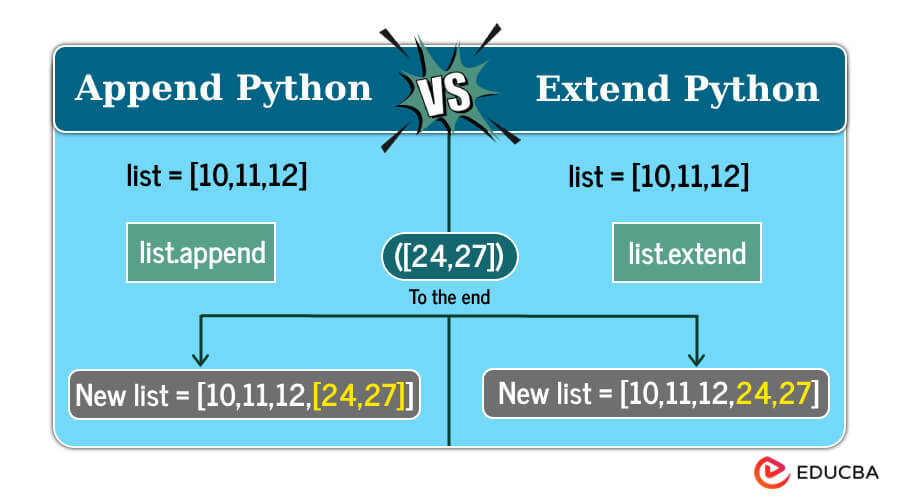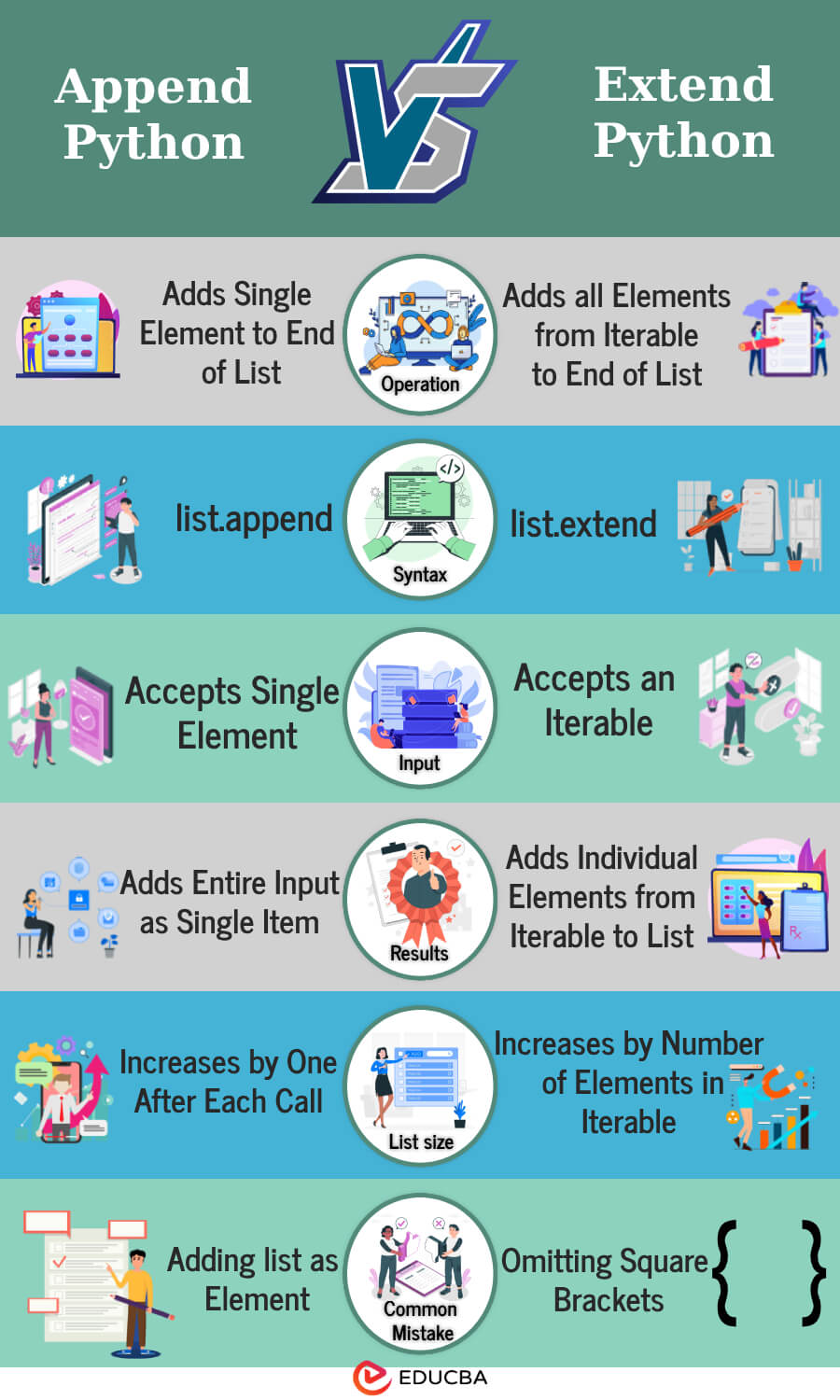Updated December 20, 2023
Introduction of Append vs Extend Python
In Python list manipulation, the dynamic duo of append() and extend() are indispensable for adding elements. Though their names might sound similar, a closer inspection reveals nuanced functionality and use case distinctions. Understanding the divergent paths taken by append() and extend() is paramount to navigating the intricate world of Python lists. In this introduction, let’s delve into these methods to comprehend their distinct functionalities and applications.
Table of Contents
Key Takeaways
- Both append and extend modify the original list.
- Append appends one element to the list’s end.
- Extend adds multiple elements to the end of the list.
- Append is generally faster than extend for adding a few elements.
- Stretch helps add multiple features or individual characters from strings.
Comparing Python List Methods: Append() vs Extend()
Adding elements to a list in Python can be done using either append or extend, but each serves a specific purpose. Append acts like attaching a single box to the end of a train, adding only one element. Extend merges trains, adding the elements of one list individually to the back of another. While both modify the original list, append is generally faster for adding just a few elements. At the same time, extend shines when you need to add several at once or individual characters from strings.
1. The append() Method: Adding Individual Elements
- The append() method is designed to add a single element to the end of an existing list.
- It requires one argument representing the element to be appended to the list.
- Upon execution, the original list is modified in place.
Syntax:
list_name.append(element)- list_name: The name of the list you want to add the element to.
- Element: The element you want to add to the list. This can be any data type supported by Python, such as an integer, string, float, list, or even another list.
Example #1
# Creating a list
Education = ["Educba", "is", "learning"]
# Adding an element
Education.append("Platform")
print(Education)Output:
Example #2
# Creating a list
Education = ["Educba", "is", "learning"]
# Adding a list to the existing list
ano_list=[5,0,6,7]
# Adding ano_list to Education
Education.append(ano_list)
print(Education)Output:
2. The extend() Method: Adding Elements from an Iterable
- In contrast, the extend() method adds elements from an iterable (e.g., list, tuple, string) to the end of an existing list.
- It takes an iterable as its argument and appends each element from the iterable to the original list.
- Similar to append(), this method modifies the original list.
Syntax:
list_name.extend(iterable)- list_name: The name of the list you want to add the elements to.
- Iterable: The iterable whose elements you want to add to the list. This can be any object that can be iterated over, such as another list, tuple, string, or even a generator.
Example #1
# Creating lists
learning = ["Educba", "is", "learning"]
Educat = ["Platform", "for", "Students"]
# Adding elements from another list
learning.extend(Educat)
print(learning)Output:
Example #2
# Creating lists
learning = ["Educba", "is", "learning"]
Educat = [5,0,6,7]
# Adding elements from another list
learning.extend(Educat)
print(learning)Output:
Infographics
The following is the infographic showing the key difference between Append and Extend Python.
Difference Between append() and extend() in Python
Here’s a comprehensive comparison between Append and Extend Python.
| Feature | Append() | Extend() |
| Purpose | Adds a single element | Adds multiple elements from an iterable |
| Argument | Single element | Iterable object (list, tuple, string, etc.) |
| Use cases | Adding single elements, complex objects, prioritizing performance | Adding multiple elements, iterables, prioritizing readability |
| Performance | Faster for single-element | Slightly slower due to loop iteration |
| Readability | Less readable for multiple elements | More readable for multiple elements |
| Common Mistakes | Appending an iterable instead of its elements | Confusing with insert, which adds a specific index |
Choosing Between append() and extend() in Python
In Python, the choice between append() and extend() methods depends on the use case and the data type you are working with. Here are some guidelines to help you decide when to use each method:
Use append() when:
- You wish to finish a list with a single element.
- You work with simple data types like integers, floats, or strings.
- You want to avoid nested lists.
Use extend() when:
- You want to merge multiple elements or lists into a single list.
- You are working with complex, iterable structures like sets or lists.
- You want to flatten a nested list or combine multiple lists into a single one.
Common Pitfalls and Errors
- Using append() with an iterable: This will append the entire iterable as a single element to the list, not its elements. For example, [1, 2].append([3, 4]) will result in [[1, 2], [3, 4]] instead of [1, 2, 3, 4].
- Confusing append and insert: Insert adds an element at a specific index within the list, not at the end.
- Not considering performance: While the performance difference between append and extend is often negligible, it can be significant for large lists.
- Not handling errors: If you’re adding elements from an external source, consider handling potential errors like invalid values or unexpected data types.
Best Practices
- Use extend for adding multiple elements: It’s more concise and readable.
- Use append for single elements or complex objects: ensures clear intent and performance.
- Document your code: Clearly explain the purpose of using append or extend for future reference.
- Write unit tests: Verify that your code handles different scenarios and edge cases correctly.
Conclusion
Understanding the critical differences between append and extend helps you write efficient and maintainable Python code. Choose the appropriate method based on your needs, considering readability, performance, and error handling.
FAQ’s
Q1. What if I want to add an element at a specific index?
Answer: Use insert(index, element) instead of append or extend. This method takes two arguments: the index where you want to insert the element and the element itself.
Q2. Can I use the += operator with both append and extend?
Answer: Yes, you can use the += operator with both methods. For example, my_list += [1, 2] is equivalent to my_list.extend([1, 2]).
Q3. Is there a way to check if an element exists before adding it?
Answer: You can use various methods, like operators or collections. Counter to check if an element exists before adding it with append or extend.
Recommended Articles
We hope this EDUCBA information on “Append vs Extend Python” benefited you. You can view EDUCBA’s
recommended articles for more reports.


